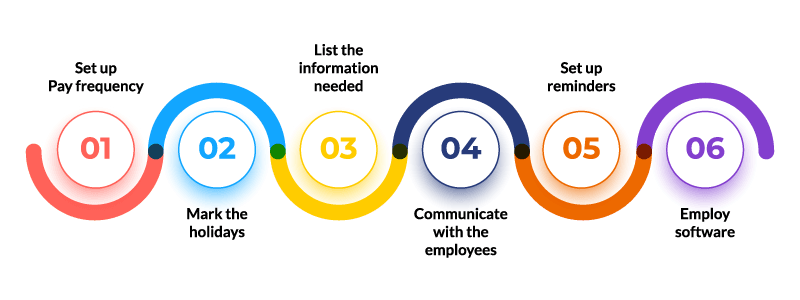Payroll Calendar: Know How To Create and Stick To Improvising of Small Businesses

Table of Contents
Being a part of a company, we must have seen the salary calculation carried out under packed schedules, many-a-times at the peak day or just at the verge of payout deadline. And with many components in consideration, a small delay in receiving one detail may end up delaying the whole process. Squeezing payroll in the hurry of gathering all the feeds should not be prevailing. This irregularity can be reduced by creating and sticking to the payroll calendar.
Moreover, as payroll processing is a recurring task every month, delaying becomes a standard norm in a small or larger business. But for a growing company, this is neither fruitful for the business nor for enhancing the employees’ productivity. Delaying payroll cannot be suitable for your employees’ satisfaction, and as a small business, you may not want to drive them away. Maintaining a payroll calendar is thus an effective way to weed out the glitch in the system. But sometimes, in the hustle of various tasks, HR may find it hard to follow. But with the routine steps to stick to the calendar, the payroll can be quicker than ever.
What is the Payroll Calendar?
Payroll Calendar shows the detailed list of the pay periods the HR has filled up. Compared with the ordinary people’s calendar, the Pay calendar would look different, showing colored days for a particular process to be done on that day. It outlines the start and end date of the pay periods and the actual pay date to keep you updated on the payroll cycle. The calendar highlights the time when one needs to start the process to reduce the time and hurry of running payout.

Why is the Payroll Calendar Essential?
With diversified employment categories, the volume and type of salary payout also change, which employers need to remember. An employee doesn’t appreciate their salary processing on or after the deadline. It highlights the more than other better approaches that the company does.
Moreover, the payroll process itself is time-consuming for those who don’t use automated software. The employer invests considerable time to collect various information regarding the statutory compliances like payroll components, bank holidays, tax funds, etc.
These steps take a lot of time to get accomplished. Meanwhile, during the process employer may forget some information to collect, thus delivering the wrong payroll. This can lead to wage violations that may spark some illegal complications for the company.
To reduce this complication and offer 100% statutory payment, the use of a payroll calendar has increased. Though being useful, the employer may forget to stick to the calendar during the early days. But with proper steps designed and taken into consideration, the employer can achieve the targets precisely.
What are the Distinct Steps to Create and Stick to the Payroll Calendar?
One reason for not delivering accurate payroll can be glitches in the existing methods. The payroll calendar comes to set up the schedules of the company’s salary frequency and the dates when to start the process to accomplish the same without missing the deadlines. Sticking to that particular calendar again is essential.

1. Set up Pay Frequency
Pay frequency is the time and date when the employer pays an employee. It may change with a change in the employment type of employees. Pay frequency describes how repeatedly you pay the employees with the knowledge of the beginning and the ending dates. Based on the choice of paying employees, the pay frequency divides into few main options:
- Weekly: This is the most preferred option for hourly working employees. Calculating the work done in a week, the employees are paid once a week. Every employee with such a condition receives 52 payslips in a year.
- Biweekly: Employees with a biweekly payment category receive their wages once every two weeks. They are totally offered 26 payslips in a year.
- Semimonthly: Semimonthly payment is performed two times a month, most probable days being 1st and 15th or 15th and 30th of the month. The employees here are paid 24 times in a year.
- Monthly: The monthly paid workers are offered their wages once every month on the date mentioned as per the company’s payroll policy. They receive a total of 12 payslips in a year, one every month. The most preferred day of the month is the 7th.
The company may need to use different methods for its employees based on the job type. Thus after selecting the pay frequency of the workforce, the information is to be updated to the payroll calendar with the description of the pay periods. The pay period starts from the next immediate day of the payout.
2. Mark the Holidays
It is true that with holidays in the month, there may be gaps prevailing in between the ongoing processes. It could happen that the payday of the month falls on Sunday, and thus the employer needs to be ready priorly with all the requirements.
Moreover, with the involvement of the bank at the time of salary transfer, the employer should mark the bank holidays too to avoid interruption in the process.
Assume that all your payment process is ready to disburse with just a tap, but you forgot that the next day is a bank holiday, and you are left with zero buffer. Bewildered! There could be you in that position, but with the organized payroll calendar, no holidays can stop you from paying out to the employees on a determined day.

3. List the Information Needed
Payroll doesn’t only include the total amount of wages an employee recipes for the work done during the corresponding pay period. The employer needs to consider attendance and leave management details, overtime implications, tax withholding, and other statutory deductions.
All this information has a different time to get collected, and thus remembering that time and organizing the information is essential for the employers. Therefore, with a proper listing of the time and date, a payroll calendar can be used to take away the burden from the employer.
For example, set up a time for:
- Gathering the timesheet details
- Tax withholding
- Running payrol
- Informing the bank to transfer the salary
- Submitting the tax funds to the accounts
Complete setting up the information needed time, the employer can now process the payroll errorlessly.
4. Communicate with the Employees
After setting up the pay periods according to the employment types, the employer should inform their employees about the process, and when an employee can receive their payment. Share with them the time of submitting the timesheet details for further payroll process.
In case of any delay due to holidays or other genuine reasons, inform the employees before to avoid the charges of wage violations. Generally, the employees receive these details at the start of the year to avoid confusion at the beginning only.
5. Set up Reminders
With many ongoing processes, people find it challenging to manage the same at their accurate time. Even when the use of alarms has increased to wake up in the morning, it is no surprise that the employer needs reminders to perform the payroll on time accurately.
Whether it is cell-phone alarms or scheduled reminders of the software, if one knows the need, setting up the same can be fruitful for future processes.
For instance, you may set up an alarm about starting to gather the payroll data, collect the timesheet details from the employee, or notify the bank for the salary transfer. The payout date is actually the high time for HR to accomplish. Timely reminders can actually become a boon for them.
6. Employ Software
Indeed, to stick to the calendar and processing the payment tasks can be made more straightforward and streamlined with automated payroll software. Not that the employer gets scheduled notification but gathering all the components and accomplishing the payroll can save them valuable time.
Once synced with the calendar, the software notifies about the holidays, the pay periods, and the other integrated facilities, which may consume time if treated manually. According to studies of trinet.com, integrating the system with the timekeeping payroll reduces the mistakes by ? compared to those who use simple automation.

Wrapping Up
You can hold onto the information defined in your payroll calendar when running Payroll. However, you also need to collect timesheet data from employees to keep track of their working hours and present days. Accurately maintaining records in a timesheet requires online timesheet management software. Check out payroll software options that often integrate timesheet functionalities, helping you track hours, offering easy input options, enhancing productivity, and streamlining scheduling.
Grow your business with factoHR today
Focus on the significant decision-making tasks, transfer all your common repetitive HR tasks to factoHR and see the things falling into their place.

© 2025 Copyright factoHR


